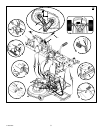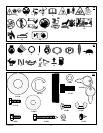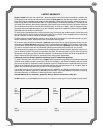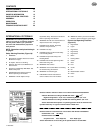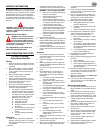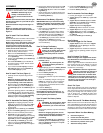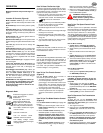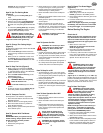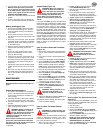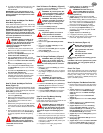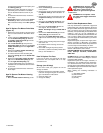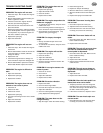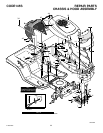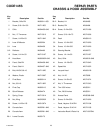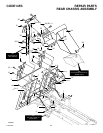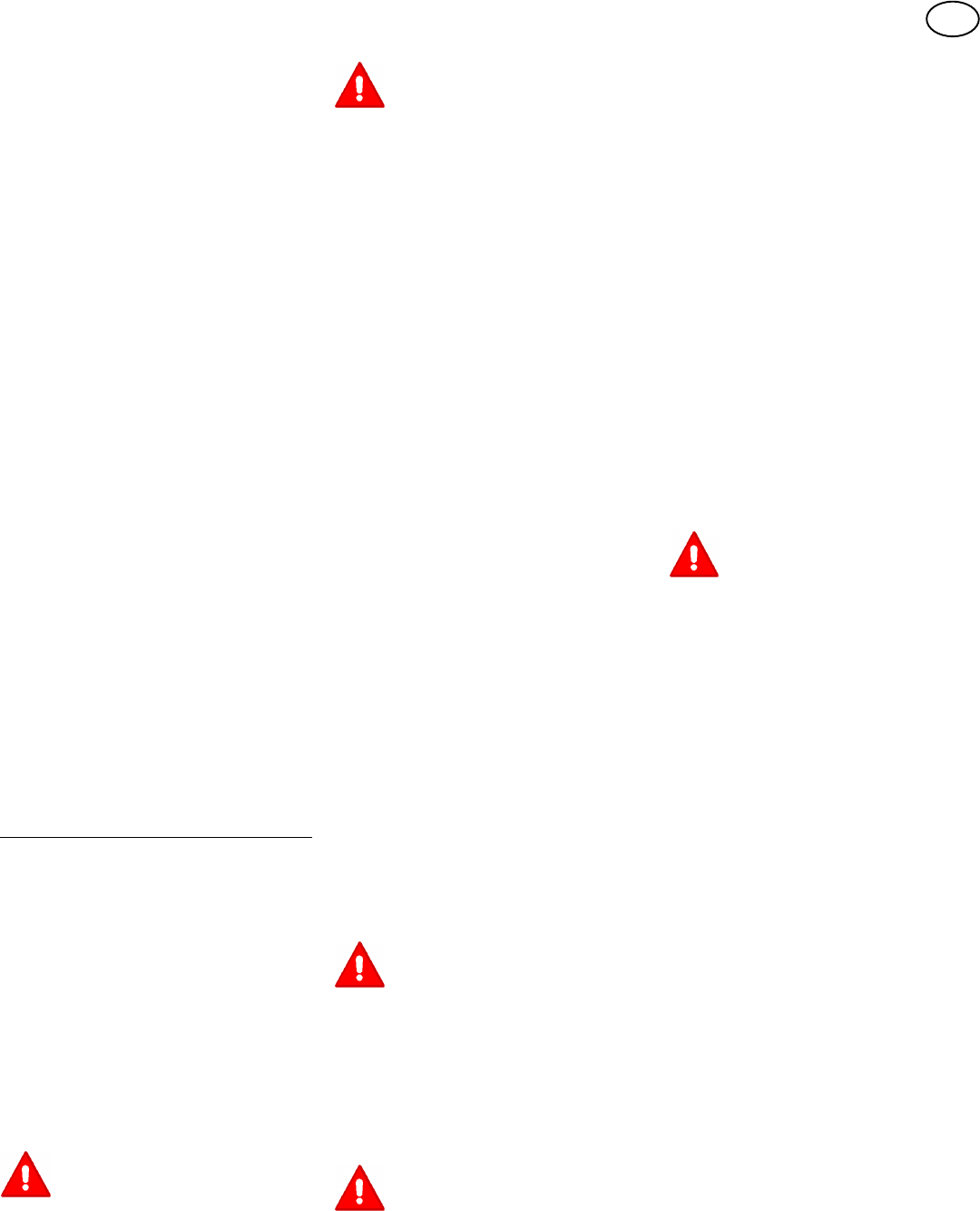
GB
17
F–000794J
4. Turn the ignition key to the START position.
NOTE: If the engine does not start after
four or five tries, move the throttle control
to the FAST position. Again try to start the
engine. If the engine will not start, see the
TROUBLE SHOOTING CHART.
5. Slowly move the throttle control to the SLOW
position.
6. To start a hot engine, move the throttle con-
trol to a position between FAST and SLOW.
Mowing And Bagging Tips
1. For a lawn to look better, check the cutting
level of the mower housing. See “How To
Level The Mower Housing” in the Mainten-
ance section.
2. For the mower housing to cut level, make
sure the tyres have the correct amount of air
pressure.
3. Every time you use the unit, check the blade.
If the blade is bent or damaged, immediately
replace the blade. Also, make sure the nut
for the blade is tight.
4. Keep the blade(s) sharpened. Worn blades
will cause the ends of the grass to turn
brown.
5. Do not cut or bag grass that is wet. Wet
grass will not discharge correctly. Let the
grass dry before cutting.
6. If the grass is very high, cut two times to de-
crease the load on the engine. First cut with
the mower housing in the highest position
and then lower the mower housing for the
second cut.
7. Operate the engine with the throttle in FAST
position and the shift lever in first or second
gear.
8. After each use, clean the bottom and top of
the mower housing for better performance.
Also, a clean mower housing will help pre-
vent a fire.
MAINTENANCE
NOTE: Illustrations and pictorials begin on
page 2.
General Recommendations
1. The owner’s responsibility is to maintain this
product. This will extend the life of the prod-
uct and is also necessary to maintain war-
ranty coverage.
2. Check the spark plug, drive brake, lubricate
the unit, and clean the air filter once a year.
3. Check the fasteners. Make sure all fasteners
are tight.
4. Follow the Maintenance section to keep the
unit in good operating condition.
WARNING: Before you make an in-
spection, adjustment, or repair to
the unit, disconnect the wire to the
spark plug. Remove the wire from the
spark plug to prevent the engine from
starting by accident.
NOTE: Torque is measured in foot pounds
(metric Nm). This measurement describes
how tight a nut or bolt must be. The torque is
measured with a torque wrench.
Inspect Blade
(Figure 10)
WARNING: Before you inspect or
remove the blade, disconnect the
wire to the spark plug. If the blade
hits an object, stop the engine. Check the
unit for damage. The blade has sharp
edges. When you hold the blade, use
gloves or cloth material to protect your
hands.
If you keep the blade (1) sharp and inspect the
blade for damage, the blade will cut better and be
more safe to operate. Frequently check the blade
for excessive wear, cracks, or other damage.
Frequently check the nut (3) that holds the blade
(1). Keep the nut (3) tight. If the blade hits an
object, stop the engine. Disconnect the wire to the
spark plug. See if the blade is bent or damaged.
Check the blade adapter (5) for damage. Before
you operate the unit, replace damaged parts with
original equipment parts. See the authorized
service centre in your area. Every three years,
have an authorized service person inspect the
blade or replace the old blade with an original
equipment part.
How To Remove And Install The Blade
(Figure 10)
1. Remove the mower housing. See the instruc-
tions on “How To Remove The Mower Hous-
ing”.
2. Use a piece of wood to keep the blade from
rotating.
3. Remove the nut (3) that holds the blade (1).
4. Check the blade (1) and the blade adapter
(5) according to the instructions for “Inspect
Blade”. Replace a badly worn or damaged
blade with an original equipment blade. See
an authorized service centre in your area.
5. Clean the top and bottom of the mower hous-
ing. Remove all the grass and debris.
6. Mount the blade (1) and blade adapter (5)
on the mandrel (6).
7. Mount the left blade (1) and the right blade
(1) so that the hi–lift edges (7) are up. If the
blade is upside down, the blade will not cut
correctly and can cause an accident.
8. Fasten the blade (1) with the original
washers (2,8) and nut (3). Make sure the
outside rim of the Belleville washer (2) is
against the blade (1).
WARNING: Always keep the nut (3)
tight that holds the blade (1). A
loose nut or blade can cause an
accident.
9. Tighten the nut (3) that holds the blade (1) to
a torque of 45 foot pounds (62 Nm).
10.Install the mower housing. See “How To Re-
move The Mower Housing”.
How To Adjust The Blade Rotation
Control
WARNING: To prevent an injury, the
blade rotation control must operate
correctly.
In normal usage, the blade rotation control will not
require an adjustment. However, if the cutting
performance decreases or the quality of cut is
poor, make the following changes.
1. When you mow, make sure the throttle con-
trol is in the FAST position.
2.
(Figure 11
) Move the blade rotation control
to the DISENGAGE position (1).
3. Stop the engine. Disconnect the wire from
the spark plug.
4. Check the blade(s). Keep a sharp edge on
the blade(s). A blade that is not sharp will
cause the tips of the grass to become brown.
5.
(Figure 12)
Disconnect the blade drive
spring (2) from the blade control rod (1).
Move the blade drive spring (2) to the
middle hole
(4). This will increase the ten-
sion on the mower drive belt.
6. Attach the wire to the spark plug. Mow for a
short distance and again check the quality of
cut. If necessary, move the blade drive
spring (2) to the bottom hole
(5)
7. Again check the quality of cut. If the quality of
cut has not improved, replace the mower
drive belt. See “How To Replace The Mower
Drive Belt”. If the replacing the belt does not
correct the problem, take the unit to an auth-
orized service centre.
8. Move the blade rotation control to the DIS-
ENGAGE position. Stop the engine.
9.
(Figure 13)
Check the operation of the blade
brake. Rotate the pulleys with your hand.
Make sure the brake pads (12) are pressed
tightly against the pulleys
WARNING: If the brake pads (12) do
not press tightly against the
pulleys, take the unit to an author-
ized service centre.
10.
(Figure 11)
Move the blade rotation control
to the ENGAGE position (2).
11.
(Figure 13)
Check the pads for the blade
brake (12). If the pads are excessively worn
or damaged, replace the brake pad assem-
blies. Correct replacement parts and assist-
ance are available from an authorized
service centre.
12.Attach the wire to the spark plug. Mow for a
short distance and again check the operation
of the blade rotation control.
13.When you move the blade rotation control to
the DISENGAGE position, all movement will
stop within five seconds. If there is move-
ment of the belt or the blades continue to ro-
tate, engage and disengage the blade
rotation control five times to remove any ex-
cess rubber from a new mower drive belt. If
you need assistance, take the unit to an
authorized service centre.
14.
(Figure 12)
If you replace the mower drive
belt, move the blade drive spring (2) to the
top hole
(3).
How To Adjust The Speed Control Pedal
(Figure 37)
If the unit will not go into REVERSE or if the unit
moves very slowly in REVERSE, adjust the speed
control pedal as follows.
1. Stop the engine.
2. Set the parking brake.
3. Remove the hair pin (2) from the adjuster
nut (1). Disconnect the adjuster nut (1) from
the transaxle lever (3).
4. Rotate the adjuster nut (1)
one turn
in the
direction shown in Figure 37.
NOTE: Too much adjustment will cause
REVERSE speed to be too fast and the
FORWARD speed to be reduced.
5. Attach the adjuster nut (1) to the transaxle
lever (3) with the hair pin (2).



